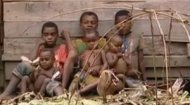|
For millennia, various indigenous communities have lived within and alongside the Congo Rainforest, developing intricate knowledge systems and sustainable practices adapted to its unique environment. Groups such as the Pygmy forest peoples (including the Aka, Baka, Mbuti, and Batwa), have a profound spiritual and cultural connection to the forest, relying on it for food, medicine, shelter, and their very way of life. Their traditional hunting, gathering, and farming methods have, for centuries, been in harmony with the forest's regenerative capacities. These communities are not merely passive residents; they are active stewards of the forest, possessing invaluable traditional ecological knowledge passed down through generations. Their intimate understanding of the forest's rhythms, its plants, and its animals is crucial for effective conservation efforts. However, they are often among the most vulnerable to the threats facing the rainforest, facing displacement, human rights abuses, and the erosion of their traditional livelihoods. Despite its immense value, the Congo Rainforest faces an escalating array of threats that jeopardize its future and, by extension, the planet's well-being as the rainforest today is subject to the highest deforestation rates of any place on Earth not least because heavily indebted nations such as the Republic of Congo can help make payments towards that debt through the timber trade, locals use the forests for burning fuel and, given the paucity of much of arable land in many of the countries in the basin, land clearance creates more opportunities for subsistence farming. It is estimated that at current rates the rainforest will have largely disappeared within the next century. |
Congo Rainforest |
Congo Rainforest |
Congo Rainforest | Congo Rainforest |

|
Deforestation and Degradation: Commercial logging, both legal and illegal, is a significant driver of forest loss, often leading to selective logging that degrades the forest and creates pathways for further encroachment. Subsistence agriculture, particularly slash-and-burn farming, driven by rapid population growth and poverty, also contributes substantially to deforestation. The expansion of industrial-scale monocultures, such as palm oil and rubber plantations, is an emerging and growing threat.
The Congo Rainforest is an irreplaceable global treasure, a vital sanctuary for biodiversity, a critical regulator of the Earth's climate, and a source of life and culture for millions. Its continued existence is not merely a regional issue but a shared responsibility for humanity. The challenges it faces are formidable, driven by complex socio-economic factors, global demand for resources, and a changing climate. However, by fostering international cooperation, empowering local communities, strengthening governance, and embracing sustainable development models, we can still hope to secure the future of this magnificent and indispensable natural wonder, ensuring that the beating heart of Africa continues to thrive for generations to come. The extent of the Congo rainforest is shown in the map below with the dark green of the rainforest stretching from the Democratic Republic of Congo, through the Republic of Congo across Cameroon and into West Africa taking in Gabon, Equatorial Guinea and south Central African Republic on its journey. The Republic of Congo rainforest is home to the Pygmy people images of which are shown left. |









